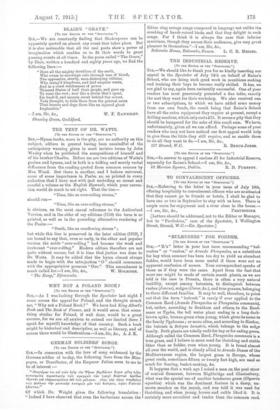"BULRUSHES" FOR FODDER.
[To SHE EDITOR OF THE "SPECTATOR."] Sin,—" B.'s" letter in your last issue recommending " bul- rushes " or "rushes," or ,Arundo Phragmites, as a substitute for hay when summer has been too dry to yield an abundant fodder, would have been more useful if there were not an apparent confusion of names. Your correspondent speaks of those as if they were the same. Apart from the fact that more use might be made of certain marsh plants, as we are told is the case in Prussia, there is often a very natural inability, except among botanists, to distinguish between rushes (luncus), sedges (Carex, (to.), and true grasses, belonging to three different families. It may be well, therefore, to point out that the term " bulrush" is rarely if ever applied to the Common Reed (Arundo Phragmites or Phragmites communis), but, rather, according to Bentham and others, to the Reed. mace or Typha, the tall water plant ending in a long dark- brown spike, bronze-green when young, which gives its name to the family Typhaceae ; or more often, and according to Hooker, the bulrush is Scirpus lacustris, which belongs to the sedge family. Both plants are totally unfit for bay or for eating green. Although called the Common Reed, Phragmites communis is a true grass, and I believe is more used for thatching and stable litter than as fodder, even when young. It is found almost all over the world, and is closely allied to Arundo Dorm of the Mediterranean region, the largest grass in Europe, whose great reeds, sometimes fifteen or twenty feet high, are used so much for fencing, basket-making, &o.
It happens that a week ago I asked a man on the peat moor of central Somerset, between Highbridge and Glastonbury, what was the special use of another handsome grass (Glycaria aquatica) ,wilieh was the dominant feature, in a damp, EH-. mown meadow on the . marsh, and was told it was used for thatching, and when . young .horses and cattle liked. it. It is certainly more succulent and tender than the common reed. Another aquatic grass, smaller and very tender as a food for tattle, is Catabrosa aquatica, which is often seen in water by roadsides. The generic name (and there is only one species) is derived from the Greek catabroma, on account of its nourish- ing properties. Dried specimens of all these and many other useful plants can be seen by farmers and others in some of our museums, at certain schools, and at agricultural colleges. It might be worth while to encourage the boys and girls at schools in rural districts to make collections of all the useful grasses. At least it would tend to develop their faculties of observation and discrimination. Indirectly it might be a means of keeping some of them from flocking into the towns.



































 Previous page
Previous page